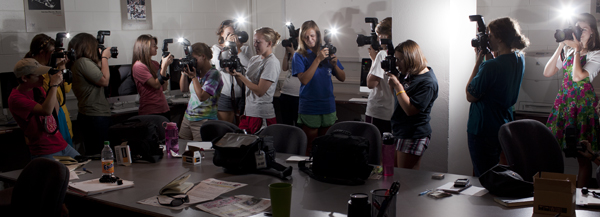Journalism Education and Technology Needs
An interesting piece in The Maneater, a student publication at the University of Missouri, about the requirement for all of their journalism students to have an Apple iPod Touch for use in their course work. It’s of particular note to me as we at the Grady College of Journalism and Mass Communication at the University of Georgia are starting to discuss what equipment students should be required to have.

Currently, we have an excellent program in place for all of our photojournalism students which supplies them with all the gear they need. Intro students are issued a digital single lens reflex camera and lens at the start of the semester which they use to complete all of their assignments. (And those assignments are tailored to that gear very carefully.) In the upper division courses, they are issued a higher-level camera body, three lenses, a flash, audio recorder and a few other widgets to make it all work. They also have access to high end bodies and specialty lenses and lighting gear.
It’s a great system, for sure. The downside? When they graduate, they tend to own nothing. EVen in the reporting classes when we introduce an audio module we supply the gear, so they don’t own anything there.
All of this eliminates financial barriers to taking the classes, but it also disengages the students from the actual costs of being a journalist.
So, where does this leave us? We are batting around the idea of requiring our students to own a couple pieces of equipment (an audio recorder, a digital camera of some sort and maybe a pocket video camera). Other programs require those and specific computer kits, too.
I understand the frustrations of the students in Missouri – it doesn’t sound like their faculty are actually incorporating the equipment into their classes. That’s a leadership problem – if 40 of 49 faculty members said they need this because they will use it in their class, then the administration needs to step in and say, hey – get with the program. (Academics, feel free to scream about your academic freedom here.)
As for the idea of not requiring anything, that opens up an entirely different problem. One of the reasons my kids are successful here is because we don’t wast time figuring out different pieces of equipment. When I was in grad school and teaching basic photo classes, I’d have 20 students with 18 different kinds of cameras in front of me. When I said check your depth of field, 15 hands would go up asking how .. and then I had to lose a couple of minutes looking at every camera and showing them how to do that. (If the camera even could.)
Here, I can teach to the gear – do this, here’s how.
If we say, “You must have a digital recorder and a digital camera with video capability,” who knows what will show up. How much time will we lose in the classroom to teaching individuals how to operate their own gear?
And if we say, “Figure it out,” the students will excoriate us in course evaluations for having not taught them how to use their own equipment.
So what is a department to do? I think stipulating specific requirements for gear is fine as long as the faculty will incorporate them into the classrooms. If you can’t ensure that, then you need to limit or eliminate those requirements.
Which will it be for us? Damned if I know …